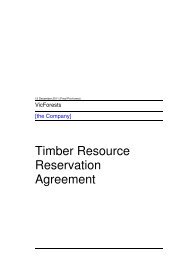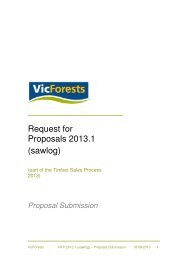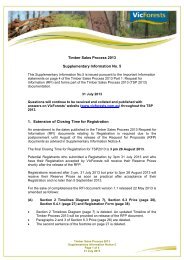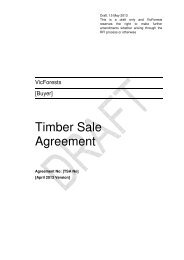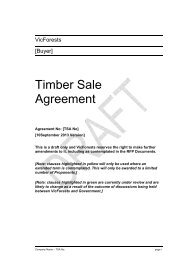Module 5 - VicForests
Module 5 - VicForests
Module 5 - VicForests
Create successful ePaper yourself
Turn your PDF publications into a flip-book with our unique Google optimized e-Paper software.
FOREST AUDIT PROGRAM TOOLBOX<br />
The procedures for field activities should include:<br />
• Examination in the field of operations that have been planned and carried out over<br />
the period that is the focus of the audit. The target sites sampled should be the<br />
same as those identified at the time of the pre-audit meeting. It may be<br />
necessary to sample additional sites as a result of operational issues, or in<br />
following up findings at the pre-selected sites, but any such field operations should<br />
first be discussed with the auditee.<br />
• Follow-up examination (as required) related to observations or queries.<br />
• Review of information made available to the audit team at the field audit stage.<br />
Observations of conditions noted during the site visits should be documented by the<br />
Auditor at the time of field assessment, and will form the support for the conclusions<br />
of the audit. Auditors will be required to store and maintain copies of such records.<br />
Auditors should discuss any notable items that they observe during the field<br />
assessment with the auditee’s representative. This should be undertaken at the<br />
closing meeting, but may be conducted by telephone if it is not possible to undertake<br />
this discussion at the time of audit.<br />
If time and resources allow, Auditors may also hold on-site meetings with the<br />
auditee’s representative(s) to discuss audit findings and non-conformance issues, and<br />
to review plans for the remainder of the relevant audit activities. However, such<br />
meetings are not compulsory if time and resources are limited.<br />
Auditors should also observe the forest when travelling between audit locations noting<br />
whether or not the observed conditions are reflected in maps or other documents.<br />
Inconsistencies, or observations suggesting negative impacts should be noted and<br />
may be followed up in subsequent investigations.<br />
Auditors are expected to provide necessary vehicles to transport the audit team<br />
during the field work. Vehicles used in audit field work must be capable of travel on<br />
forest roads, as outlined in the HSE Plan. Auditee personnel participating in the audit<br />
process may travel with the audit team if feasible, but will be responsible for providing<br />
their own transportation during site visits.<br />
Where logistical issues limit the numbers of people that can be transported on site to<br />
take part in the field assessments, the Auditor should ensure that highest priority is<br />
given to the audit team members and the auditee personnel that are most relevant to<br />
the sites being examined. Other individuals will be accommodated where possible, to<br />
the extent that space allows.<br />
After completion of the field assessments within each region, the audit team will hold<br />
a closing meeting with the auditee and DSE. The main purpose of these meetings is<br />
to present preliminary audit findings in such a manner as to ensure that the factual<br />
basis of the findings is clearly understood.<br />
Disagreements on factual information presented at these meetings should be resolved<br />
(if possible). It is preferable that any resolution occur before the Auditor issues the<br />
FOREST AUDIT PROGRAM – MODULE 2 AUDIT PROCESS PAGE 12




